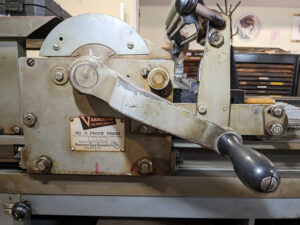The impression (using the ‘rule test’ in the book w/no ink) is noticeably and consistently light on the operator side, so we suspect the operator side of the carriage needs to be lowered. We also noticed that the “ceiling” of the Under Rail is somewhat worn (you can feel a very slight lip on it for a short length around the center of the bed).
We’ve read Paul’s comments on this Briarpress post (https://briarpress.org/58765) and referencing the illustration in the book. It seems that our “steady roller” has the eccentric adjustment that’s pictured in the book (and Paul’s description in that post) for the “carriage rollers” and our “carriage rollers” have a different type of adjustment (outer nut with tabbed bolt, see photo). So we’re unsure where to start. Presumably the carriage rollers can be adjusted by holding the bolt with a wrench and turning the nuts with a bigger wrench.
So I think we understand HOW to make the adjustments, but we’re unclear on the overall (and feeler-gauge) procedure. Are the carriage rollers supposed to be tight against the ceiling of the Under Rail? Is that wear a problem or a symptom?
Incidentally, the carriage gears feel a tiny bit loose in the tracks, the hand crank has a little play, so we suspect lowering the carriage might take up some of that play as well? Is that play normal or a bad sign?
Thanks to anyone that has insight!


So glad you could get these bearings adjusted, Matt. And thank you for your appreciation of the book. Thank you midwestephemera for your assessment of the instructions. It’s a goal for the next edition is to make it easier to understand. I welcome all text suggestions.
Seconded, thanks for your help, Paul! If I may suggest dumbing down the explanation a bit, it might help, something like:
“Loosen the outer nut, then turn the inner adjustment bolt (clockwise, iirc?) until the gauge is tight between the ‘ceiling’ and the bearing, then barely back it off to where the gauge slides in and out without any extra play. Continue to hold the inner bolt in place as you tighten the outer nut.”
The illustrations of the different bearing types will help a lot, and that “In Trip…” paragraph (from your reply here) is super useful to explain the desired end result.
The “rule test” was the perfect way to illustrate the problem, and to confirm that the adjustments fixed the problem.
Like Matt said, the book is amazing and essential, thank you for everything you’re doing and please never stop.
Many thanks, Paul, for the guidance! It was very straightforward once we dug in, and we managed to make these adjustments without much trouble.
A little PB blaster in the morning to free up the rusty/inky/crusted-over parts and appropriate size wrenches (that lock nut is over 1″) go a long way!
This might go without saying but The Book is an invaluable resource. Between that and this blog, I’ve repeatedly found that nearly every answer is out there if you do some research first and ask the right questions, and adjustments and repairs are always much easier than I anticipate.
Your assumption about how to adjust the carriage bearing is almost correct:
Loosen the nut, then turn the bolt with another wrench. After adjustment, hold the bolt as you retighten the nut.
The feeler gauge is slipped between the under rail (ceiling) and the bearings.
Carriage bearings that are too tight against the under rail will wear that rail as will build-up of grime and a press that is unlevel across the bed.
In trip, the carriage feels loose because there is daylight between the cylinder bearers (bands next to the gears) and the bed bearers (top rails). In other words, the bearers are not bearing the weight of the impression cylinder. The carriage should not feel loose in print. If so carriage bearing adjustment needs to be made.
For the next edition of my book, I’ve added new drawings showing the carriage bearings for the most common press models.